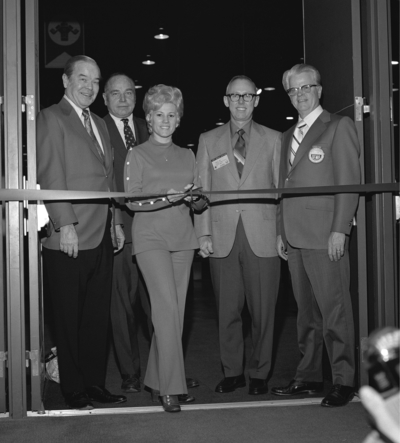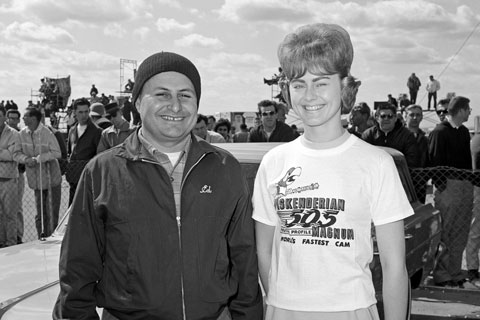SEMA News—November 2020
HERITAGE
SEMA Show 1971: Performance Past Meets the Future
By Drew Hardin
Photography Courtesy Pat Brollier, Petersen Publishing Company Archive
 |
The VIPs chosen for the ceremonial ribbon cutting to open the 1971 SEMA Show represented the past, present and future of automotive performance. Doing the honors with her “shifting hand,” as Hot Rod Industry News (HRIN) described it, was drag racer Shirley Shahan. She was joined by (from left) Willie Garner, Don Jensen, Doug Toms and Roy Richter.
Shahan, nicknamed the “Drag-On Lady,” is one of just a few women who fought their way to recognition and success in the early days of drag racing. She spent much of the ’60s campaigning a series of Hemi-powered Plymouths and Dodges, then switched camps to American Motors and raced the very first Super Stock AMX built by Hurst in 1969. For the 1971 season, her crew chief and husband, H.L. Shahan, built a Gremlin and two Hornets for them to race in the then-new Pro Stock class.
Garner and Richter were automotive aftermarket pioneers who were influential in the founding and early guidance of SEMA. Garner started Trans-Dapt Performance out of his garage in the ’50s, making and selling transmission adapters. He served as SEMA president in the ’60s and was on the SEMA Board of Directors in 1971. Richter, SEMA’s president in 1971, had been a racer and sprint-car builder in the ’30s; took over one of Southern California’s original speed shops, Bell Auto Parts, in the ’40s; and would launch two iconic brands: Bell Helmets in the ’50s and Cragar Wheels in the ’60s.
Everyone was all smiles in the photo, but these were turbulent times in the performance industry. The founding of the U.S. Environmental Protection Agency in 1970 brought new regulations to address air pollution—regulations that would fundamentally change the automotive landscape.
Jensen, director of automotive emissions for Ford Motor Company, and Toms, director of the National Highway Safety Bureau, had been invited by SEMA to “tell it like it is” at a pre-Show luncheon, HRIN reported. “Those in attendance listened intently as first Toms and then Jensen discussed topics of great interest and concern to literally everyone who owns or drives an automobile.”
The theme common to the two talks, HRIN said, was that aftermarket companies should “work with the government and other groups concerned with the environment in a positive way.”
Looking into the future, Toms told the group that the internal-combustion engine would be around for at least another 10 to 15 years, and possibly longer. “You fellows have too many resources, too much talent, and far too much inventive fire to allow any other conclusion. I think you’ll satisfy the demand for clean air and acceptable noise levels.”
“The high-performance industry will have to commit itself to the solution of air pollution just as the Detroit automakers have had to do,” Jensen said. “Today we know that some sacrifices are going to have to be made, and such things as economy and performance might have to give way to lower automobile emissions.”
(That thinking about fuel economy would change in the not-too-distant future as the first oil embargo hit the United States in 1973.)
Jensen agreed with Toms that the internal-combustion engine “is not doomed in the foreseeable future,” the magazine said, “although he mentioned several alternate power sources that are being explored. He predicted that the automotive aftermarket, including the performance industry, can grow and prosper if they are prepared for the changes that are taking place.”






